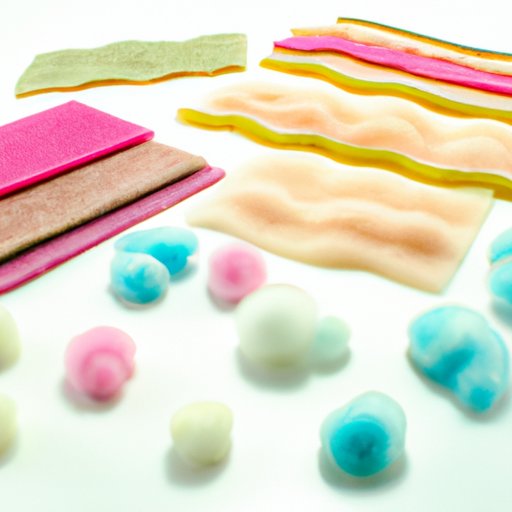
Introduction
Needle felting is a popular craft that involves using a barbed needle to create 3D sculptures and designs using natural wool fibers. Not only is needle felting a fun and rewarding hobby, but it also allows for endless creativity and imagination. Whether you are a seasoned needle felter or a complete novice, this beginner’s guide will provide you with all the information you need to create your very own wooly masterpiece.
The Basics of Needle Felting: A Step-by-Step Guide
Before you begin needle felting, you will need some basic materials including wool roving, felting needles, and a foam pad or sponge. There are different types of felting needles that are used for different purposes, including single needles or multiple needles attached to a handle. A foam pad or sponge is essential for supporting your work as you needle felt.
Once you have your materials, you can begin the process of needle felting. Start by pulling off a small piece of wool roving and gently rolling it into a ball shape. Place the wool ball onto your foam pad and use your needle to repeatedly poke it, working in a circular motion until the wool fibers begin to tangle and form a solid shape.
As you continue to poke the wool, it will become more firm and compact. You can then begin to shape it into the desired form by using your needle to sculpt and mold it. For example, you could create a small animal or flower by shaping the wool with your fingers and needles.
Creating Your Own Wooly Masterpieces: Tips for Needle Felting Success
One of the most important aspects of needle felting is creating texture and dimension in your work. This can be achieved by using different colors and types of wool, and varying the amount of pressure applied with your needle. You can also add extra fibers onto the surface of your work to create visual interest and depth.
Blending colors effectively is another key technique in needle felting. By mixing small pieces of different-colored wool together, you can create a new color that will add visual interest to your work.
To create different shapes and forms in your needle felting, you can use different techniques such as layering wool over a pre-made shape, or creating multiple separate parts and attaching them together using your needle.
Discover the Art of Needle Felting: A Beginner’s Guide
Trying needle felting for the first time can offer many benefits such as reducing stress, improving fine motor skills and producing beautiful and unique pieces. Most beginners start with simple projects such as small animals, flowers or even a decorative scarf or two.
Common mistakes made by beginners to avoid include applying too much pressure, overworking the wool, and not using a foam pad to support the project. To avoid these issues, start with small projects and take breaks when necessary.
A beginner’s tutorial on needle felting that covers basic techniques along with tips and tricks can be very helpful in getting started.
Needle Felting: From Materials to Masterpiece
The type of wool you use in your needle felting largely depends on the desired outcome of the piece. Some types of wool such as Merino and Alpaca are commonly used because they are soft and easy to needle felt. Other types such as Corriedale or Romney can offer a thicker texture and are ideal for larger, more textured projects.
When selecting the right needle for a specific wool type, a general rule of thumb is to use a finer needle for finer types of wool and a coarser needle for thicker types.
When creating needle felted pieces, it is important to use a background fabric that will enhance the overall effect. Generally, dense fabrics such as felt or wool work the best, but experimenting with different fabrics such as silk or cotton can add visual interest as well.
The Joy of Needle Felting: Tips and Techniques for a Fun and Rewarding Craft
Needle felting can be a fun and relaxing craft that allows you to express your creativity and imagination. Working with sharp tools, however, requires diligence and safety precautions such as wearing gloves and working on a proper work surface.
If you want to customize a needle felting project for a specific occasion or gift, consider adding personal touches such as using a recipient’s favorite colors or creating a certain shape that represents something they enjoy.
Needle Felting 101: Essential Tools and Techniques
To begin needle felting, it is important to have the basic materials such as wool roving, felting needles, and a foam pad. Using a felting brush or a multi-needle tool can make the process go faster or making flat shapes such as felted scarves and afghans.
There are different techniques to add texture, dimension, and detail to your needle felted piece, including layering, building shapes by attaching masses of wool, and adding details like felted beads or trimmings.
Unlocking the Secrets of Needle Felting: Tips and Tricks for Creating Amazing Gifts and Decorations
Needle felted items make great gifts or decorations and can be customized with personal touches for specific recipients. Popular projects include animals, flowers, and decorative items such as Christmas ornaments or table runners.
Adding personal touches such as initials or unique shapes can make a needle felted gift incredibly meaningful. To display needle felted pieces effectively, choose the appropriate display method- you can hang them on the wall or display them on a shelf or table.
Conclusion
Needle felting is a fun and rewarding hobby that allows you to unleash your creativity and imagination onto a piece of wool. By following the tips and techniques outlined in this beginner’s guide, you will be able to create your very own wooly masterpiece and enjoy the relaxing and rewarding experience of needle felting.




